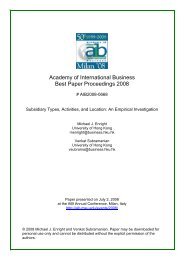AIB 2012 Conference Proceedings - Academy of International ...
AIB 2012 Conference Proceedings - Academy of International ...
AIB 2012 Conference Proceedings - Academy of International ...
Create successful ePaper yourself
Turn your PDF publications into a flip-book with our unique Google optimized e-Paper software.
TUESDAY<br />
The Changing Nature <strong>of</strong> Global Integration: Antecedents <strong>of</strong> Parent and Affiliate Product Transfers<br />
Heather K Berry, George Washington University<br />
Aseem Kaul, University <strong>of</strong> Minnesota<br />
In this paper, we study the factors that drive the direction <strong>of</strong> resource transfers within MNCs. We argue that<br />
different benefits from global integration will drive different configurations <strong>of</strong> intra-firm transfers. More<br />
specifically, aggregation benefits from exploiting organizational endowments on a global scale will be associated<br />
with transfers from parents, while arbitrage benefits from accessing location-specific advantages will drive<br />
multilateral transfers from affiliates. Results from a unique panel <strong>of</strong> 33 US manufacturing industries between<br />
1989 and 2004 show support for these arguments, highlighting a significant increase in intra-firm product<br />
transfers from affiliates, driven by foreign knowledge-seeking activities and the threat <strong>of</strong> foreign rivals. This<br />
paper thus extends our theoretical understanding <strong>of</strong> global integration, while providing empirical insights into<br />
the changing nature <strong>of</strong> global product transfers. (For more information, please contact: Heather K Berry,<br />
George Washington University, USA: berryh@gwu.edu)<br />
Firms as Catalyst <strong>of</strong> Within Country Migration Evidence from a Randomized Intra-Firm Experiment in India<br />
Prithwiraj Choudhury, University <strong>of</strong> Pennsylvania<br />
Tarun Khanna, Harvard Business School<br />
In the face <strong>of</strong> rapid growth, technology firms in countries like India face severe labor shortages. Such firms also<br />
face physical and informational barriers in hiring talented individuals from remote locations and from<br />
disadvantaged social groups. However, investing in hiring such individuals might lead to higher pay<strong>of</strong>f in<br />
equilibrium. Our empirical setting is "INDTECH," one <strong>of</strong> India's largest information technology (IT) firms where<br />
we exploit the pre-existence <strong>of</strong> a randomization <strong>of</strong> entering talent across the available projects in the 10<br />
development centers INDTECH runs across India. This randomization helps us evade econometric problems that<br />
plague studies that measure employee productivity within firms. We use hand collected data on personal<br />
records and migration patterns for entry level employees recruited by INDTECH in 2007 from over 250<br />
educational institutions all across India. We find that employees from remote locations outperform talent<br />
sourced from mainstream locations provided the distance <strong>of</strong> migration is less than 500 miles. Further, the nonmainstream<br />
talent appears disproportionately to use the firm as a platform for further advanced education.<br />
Also, talent from underrepresented social strata outperforms that hired from mainstream social communities.<br />
(For more information, please contact: Prithwiraj Choudhury, University <strong>of</strong> Pennsylvania, USA:<br />
prithw@wharton.upenn.edu)<br />
The Role <strong>of</strong> Absorptive Capacity Routines and Attention Directing Mechanisms in Adoption <strong>of</strong> a Management<br />
Innovation<br />
Carine Peeters, Université libre de Bruxelles<br />
Silvia Massini, University <strong>of</strong> Manchester<br />
Arie Y. Lewin, Duke University<br />
This paper studies how the organization level <strong>of</strong> directing attention (C-level or local) mediates the absorptive<br />
capacity (AC) <strong>of</strong> an organization in the adoption and implementation <strong>of</strong> a management innovation. Drawing on<br />
two in-depth case studies, it provides empirical evidence <strong>of</strong> organizational routines underlying AC capabilities<br />
and shows that two different configurations <strong>of</strong> AC practiced routines in different organizations can lead to<br />
successful implementation <strong>of</strong> the same management innovation, namely the reconfiguration <strong>of</strong> firms' value<br />
chains through sourcing <strong>of</strong> business services from low cost countries. However, the organizational level for<br />
directing attention and guiding adoption <strong>of</strong> the innovation affects the time to successfully implement the<br />
management innovation. Specifically, the cases suggest that the C-level ‘attention-directing' mechanism as it<br />
relates to legitimating and facilitating implementation <strong>of</strong> the new practice is more time efficient than<br />
problemistic search or local directing attention mechanisms. Moreover, the application <strong>of</strong> certain AC routines<br />
are more important in the early stages <strong>of</strong> articulating, developing and implementing the management<br />
<strong>AIB</strong> <strong>2012</strong> <strong>Conference</strong> <strong>Proceedings</strong><br />
Page 249

















